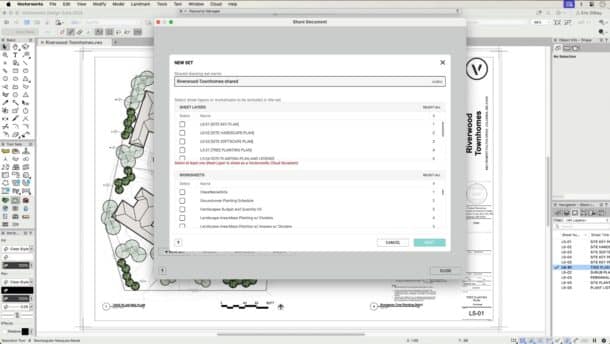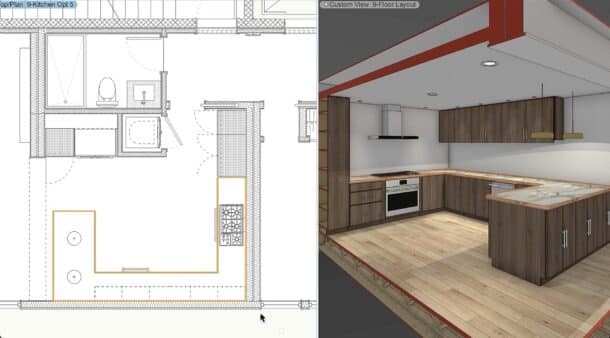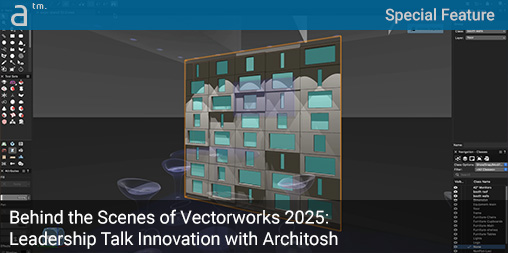Continued from page 2
BIM Competitiveness
BIM tools were severely tested during the COVID-19 pandemic when users learned all about the challenges of remote work. Vectorworks Project Sharing technology reached industrial strength in terms of robustness last year, but Dr. Sarkar noted that they continued to find further ways to increase its robustness. The big news this year is the simplified setup processes for users, which will get all types of teams up and running faster for hybrid BIM workflows.
While distributed work is critical in the present post-pandemic context, it has also driven up the need for better collaboration capabilities. So this year, Vectorworks introduced Vectorworks Cloud Document Reviewer.
The cloud-based Document Reviewer allows users to share both documents and worksheets with anyone via a browser. Once shared, recipients can select areas or objects of interest and leave comments for collaboration. They can also scale objects using a tape measure tool. And for more detailed quantification, they can access an Object Info palette inside Documents Reviewer, where they can see area info for some objects and review the same object data available on the desktop application, including any custom records and ifc_pset used on BIM projects.
“We are starting with your sheets [drawing documents] and worksheets,” says Dr. Sarkar, “but in the next few versions, Reviewer will become a full 2D/3D functioning environment. That is what we are working towards.”

The new Reviewer won’t remain a 2D-only environment for too long. The Maryland, US-based BIM giant intends to bring in full 3D model viewing in the next few releases.
This new cloud tool is going to become Vectorworks’ own CDE (common data environment) tool with an API system that will enable it to talk to other cloud tools. “This will become more meaningful when we have tighter integration with Bluebeam, for example,” adds Dr. Sarkar. “We will be able to get Bluebeam information into Reviewer and can pass that information back and forth between the cloud systems.” In other words, this is the two-way cloud-to-cloud API world that is the future direction for AEC software and, very specifically for Nemetschek, the pathway to gaining more cross-synergies and benefits between Nemetsheck Group products.
For those who don’t follow Bluebeam’s developments closely, the sister company is en route to taking the bulk of its Revu and Studio Sessions capabilities to the cloud. In fact, Studio Sessions are now a part of Bluebeam Cloud, so we can imagine multiple ways in which Vectorworks Document Reviewer can begin to tie in and leverage Bluebeam’s popular collaboration technologies. Stepping back, the new Reviewer is a surprising development but an extremely positive one.
Other New Features
Other new features for AEC professionals include more advancements in managing room finishes for your project. Using the Room Finishes Manager, users have much more flexibility and power in managing finishes inside rooms.
“The ‘space object’ used to be the method for applying this material data, but it was limited to north, south, east, and west walls,” says Darick DeHart. “Now, there are no limits. And we can also support multiple finishes per wall and track ceiling and floor finishes.” One thing that the system does is allow you to input percentages for multiple materials per wall. The tools are data-based, not visual-based, but the system and interface are very visual in how they work.
Complimenting last year’s new intelligent cabinetry tools, this year Vectorworks Architect 2025 introduces a new countertop tool that can intelligently place countertops over the new intelligent cabinet elements. You can also manually define where countertops go, even if they are not over cabinets. The new tool gives the user complete control over the edge design of a counter. It can automatically help users create backsplashes and waterfall edges, plus automatic holes based on interfaces with plumbing fixture objects like sinks and faucets.

The new Countertop Tool follows up on last year’s excellent new intelligent Cabinetry Tool. The tools work hand-in-glove with each other, but users can use the Countertop Tool without relying on a cabinet below it as well.
Other interesting new features and improvements include BIM classification support, including support for international and national standards and sub-classification, plus data tags that dovetail with the new room finishes features. Veteran users will appreciate the new Clip Cube support for hidden line render mode as well as dashed hidden line mode. They will also enjoy the Workspace Editor updates and the Migration Manager to help smooth transitions from one version of Vectorworks to another.
Additionally, there are a host of new features in the industry’s vertical products, including Landmark and entertainment industry solutions. However, in this article, we will stick to just core technologies and those for BIM in architecture and interior design. [You can learn more about the new 2025 release for Vectorworks Landmark and Vectorworks Spotlight here.]
Final Comments
We began this article by noting how Vectorworks 2025 can export out BIM models to multiple older versions of Revit and how useful that actually is in the day-to-day of AEC projects. Items like this are actually pain points that AEC professionals confront every day.
Clearly, the North American AEC market and foreign equivalents like the EU have different sets of industry challenges. The reason I mention this is it serves to address a question posed to Dr. Sarkar about the landmark Autodesk and Nemetschek Group API sharing agreement announced earlier this year. A question that emerged was why the ODA libraries would continue to hold value in light of the API sharing agreement.
Dr. Sarkar tells me that the ODA and the API agreement are parallel paths to the same thing—namely, better industry interoperability. Both have their place and role in the ongoing development of Vectorworks, and interestingly, having Autodesk APIs to work with won’t be a magic pill.
“The API is fine, but you still have to translate a Revit wall into a Vectorworks wall, and that is where the main work lies,” he notes. “Whether you use the API or the ODA library or both, the work is still there on the translation side.”
The most exciting aspect of Vectorworks 2025 is its transformative approach to the design process… Vectorworks is putting more emphasis on the user experience as we advance.
Noting that I have already heard that part of the push for the API agreement was to provide access to Autodesk Construction Cloud from Nemetschek BIM tools, Dr. Sarkar clearly stated: “As you are aware, a majority of our architectural uses are in Europe, and they have less interest in collaborating in their projects using Autodesk Construction Cloud (ACC) or BIM 360, so we don’t currently hear this request much but that may change in the future.”
And speaking of the future, I asked Dr. Sarkar what impressed him about this latest Vectorworks version. “The most exciting aspect of Vectorworks 2025 is its transformative approach to the design process,” he says, something that is evident in the new visibility options taken down to the object level as well as the new onscreen controls that boost efficiency working in 3D models. Dr. Sarkar says that this release strikes an “impressive balance between simplifying tasks and deepening existing functionalities.”
More than that, the improvements provide flexibility at the individual user optimization level and the group collaborative optimization level. Dr. Sarkar simply notes, “In other words, Vectorworks is putting more emphasis on the user experience as we advance.”



